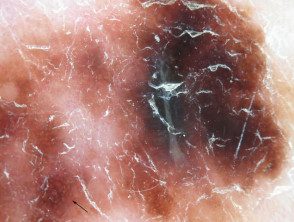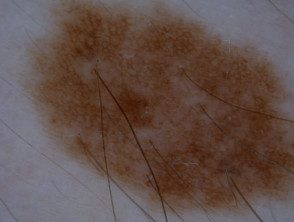Ad
Skin cancer
Application to facilitate skin self-examination and early detection. read more.
What is dermoscopy?
Dermoscopy or dermoscopy refers to examining the skin using the surface of the skin. microscopy, and is also called "epiluminoscopy" and "epiluminescent microscopy". Derm (at) Oscopy is mainly used to evaluate pigmented skin lesions. In experienced hands it can facilitate diagnosis. melanoma.
Dermoscopy requires a high-quality magnifying lens and a powerful lighting system (a dermatoscope). This allows you to examine the structures and patterns of the skin. There are several different and lightweight handheld devices that run on batteries. Convenient accessories allow video or photography, even through a smartphone.
Dermoscopy

Skin exam

Photography
Computer software can be used to archive dermoscopy images and enable expert diagnosis and reporting (mole mapping). Smart programs can aid diagnosis by comparing the new image with stored cases with typical characteristics of benign and evil one pigmented skin lesions.
Dermoscopic features of pigmented lesions.
Using dermoscopy, the pigmentation of the injury it is evaluated in terms of color (s) and structure.
Colors found in pigmented skin lesions include black, brown, red, blue, gray, yellow, and white.
The colors of dermoscopy.

Common nevus
The characteristics of the dermoscopic structure of skin lesions include:
- Symmetry or asymmetry
- Homogenesis / uniformity (equality) or heterogeneity (structural differences in the lesion)
- Distribution of pigment: brown lines, dots, clods and unstructured areas
- Skin surface curbSmall white cysts, crypts fissures
- Vascular morphology and pattern: regular or irregular
- Edge of lesion: fading, sharp cut or radial streaks
- Presence of ulceration
There are specific dermoscopic patterns that help in the diagnosis of the following pigmented skin lesions:
- Melanoma
-
Polka dots (benign melanocytic nevus)
-
Freckleslentigines)
- Atypical naevi
- Blue nevi
- Seborrheic keratosis
- Pigmented basal cell carcinoma
- Hemangioma
Skin lesions seen by dermoscopy.

Basal cell carcinoma

Seborrheic keratosis

Hemangioma

Benign lentigo

Early melanoma

Benign Melanocytic Nevus
Dermoscopy can also be used for a detailed examination of the skin surface in some other circumstances, for example:
- Unpigmented skin lesions.
- Find a scabies Pinch within a burrow
- Locating a splinter
- Examine the nail fold capillaries in cutaneous lupus erythematosus or systemic sclerosis
- Distinguish certain skin conditions, such as lichen planus, from others, such as psoriasis or eczema
- Evaluating hair loss (trichoscopy)

